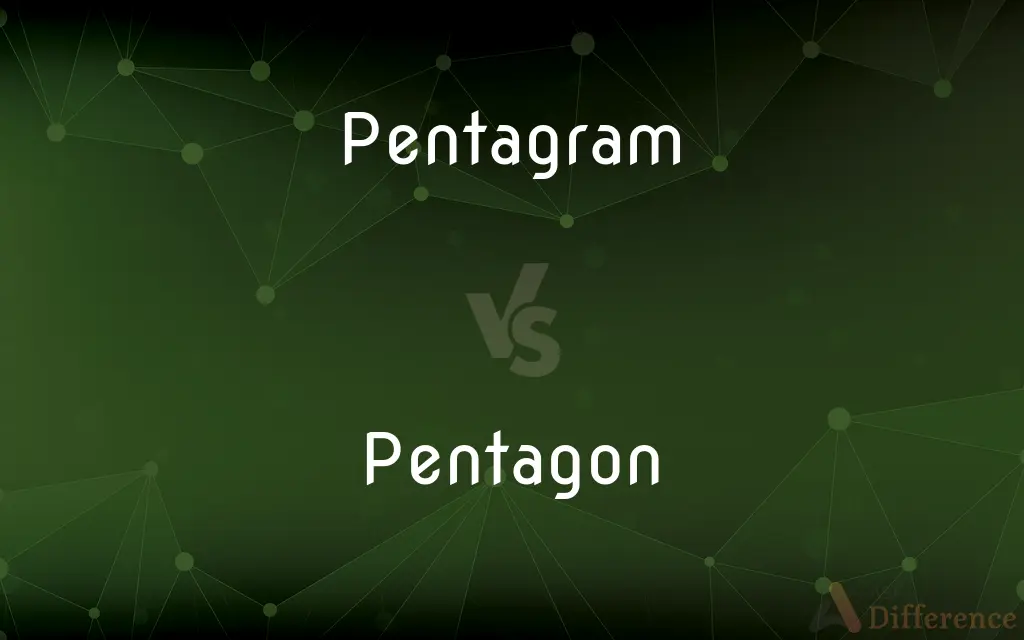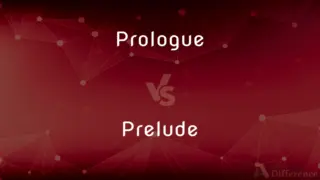Pentagram vs. Pentagon — What's the Difference?
By Tayyaba Rehman & Maham Liaqat — Updated on March 31, 2024
A pentagram is a five-pointed star often used in symbolism, whereas a pentagon is a five-sided polygon used in geometry.

Difference Between Pentagram and Pentagon
Table of Contents
ADVERTISEMENT
Key Differences
The pentagram is characterized by its five-pointed star shape, which has been used in various cultures and religions to symbolize different concepts, such as the elements or protection. On the other hand, the pentagon is a geometric shape with five straight sides and five angles, commonly seen in architecture and design.
A pentagram is often associated with mystical and magical connotations, being a significant symbol in paganism, witchcraft, and Freemasonry. It can represent the harmony of the elements and the universe. Whereas, the pentagon is devoid of such mystical attributions, focusing more on its geometric properties and applications in real-world objects, such as the Pentagon building in the United States.
The orientation of a pentagram can also carry different meanings, with the upward pointing star often seen as a symbol of balance and protection, while an inverted pentagram might be associated with occultism and darker themes. In contrast, the orientation of a pentagon does not change its meaning or properties, emphasizing its role as a basic geometric figure.
In art and culture, the pentagram has been a subject of fascination and interpretation, featured in various emblems, logos, and artistic creations to evoke a sense of mystery or power. The pentagon, while it may also appear in logos and designs, is appreciated for its aesthetic simplicity and symmetry rather than any symbolic depth.
The pentagram is closely tied to the concept of the Golden Ratio, with its points and intersections often representing an ideal of mathematical beauty and harmony. The pentagon, while it can also embody the Golden Ratio in its proportions, is primarily appreciated for its straightforward geometric presence and utility in design and construction.
ADVERTISEMENT
Comparison Chart
Shape
Five-pointed star
Five-sided polygon
Symbolism
Magic, protection, elements
None specific; geometric shape
Cultural Significance
High (religion, mysticism, art)
Moderate (architecture, design)
Orientation Meaning
Upward: protection, balance; Inverted: occultism
Orientation does not alter meaning
Association with Golden Ratio
Often associated, symbolizing beauty and harmony
Less directly associated
Compare with Definitions
Pentagram
Has both positive and negative connotations based on orientation.
The inverted pentagram is often associated with occult practices.
Pentagon
Represents a basic geometric figure in mathematics.
In geometry class, we learned how to calculate the area of a pentagon.
Pentagram
A symbol consisting of a five-pointed star.
The pentagram is often seen in ancient amulets for protection.
Pentagon
Shape of the U.S. Department of Defense headquarters.
The Pentagon is one of the largest office buildings in the world.
Pentagram
Used in ceremonial magic and various belief systems.
The ritual involved drawing a pentagram for protection.
Pentagon
Used in various logos and designs for its symmetry.
The company’s logo is a simple but effective blue pentagon.
Pentagram
Can symbolize the harmony of the universe.
The pentagram was used in the ceremony to represent cosmic harmony.
Pentagon
Does not inherently carry mystical or symbolic meaning.
Unlike the pentagram, the pentagon is primarily appreciated for its geometric properties.
Pentagram
Represents the elements of earth, air, fire, water, and spirit.
Each point of the pentagram symbolizes a different element.
Pentagon
A five-sided polygon
Pentagram
A pentagram (sometimes known as a pentalpha, pentangle, pentacle or star pentagon) is the shape of a five-pointed star polygon. Pentagrams were used symbolically in ancient Greece and Babylonia, and are used today as a symbol of faith by many Wiccans, akin to the use of the cross by Christians.
Pentagon
In geometry, a pentagon (from the Greek πέντε pente and γωνία gonia, meaning five and angle) is any five-sided polygon or 5-gon. The sum of the internal angles in a simple pentagon is 540°.
Pentagram
See pentacle.
Pentagon
A polygon with five sides and five angles.
Pentagram
The shape of a five-pointed star constructed of five intersecting lines meeting at the vertices, such that a central pentagon and five surrounding isosceles triangles are formed; often with magical connotations; a 5/2 (or 5/3) star polygon.
Pentagon
Pentagon A five-sided building near Washington DC, containing the US Department of Defense and the offices of the US Armed Forces. Used with the.
Pentagram
A pentacle or a pentalpha.
Pentagon
(geometry) A polygon with five sides and five angles.
Pentagram
A star with 5 points; formed by 5 straight lines between the vertices of a pentagon and enclosing another pentagon
Pentagon
A fort with five bastions.
Pentagon
A plane figure having five angles, and, consequently, five sides; any figure having five angles.
Pentagon
A government building with five sides that serves as the headquarters of the United States Department of Defense
Pentagon
The United States military establishment
Common Curiosities
What is a pentagon?
A pentagon is a five-sided polygon, a basic geometric shape with applications in mathematics and design.
What is the significance of a pentagon's shape?
The pentagon's shape is significant in geometry and architecture for its aesthetic and structural properties.
How are pentagrams used in culture?
Pentagrams are used in various cultures for symbolism, including in religious, magical, and mystical contexts.
Is there any symbolic meaning to a pentagon?
Generally, the pentagon is not associated with symbolic meanings and is appreciated for its geometric qualities.
Do pentagrams have a place in modern culture?
Yes, pentagrams continue to appear in modern culture, often associated with fantasy, mysticism, and alternative spirituality.
Can the orientation of a pentagram change its meaning?
Yes, the orientation of a pentagram can symbolize different things, such as protection or occult practices.
What is a pentagram?
A pentagram is a five-pointed star, often used in symbolic contexts to represent various elements or concepts.
Are pentagrams considered protective symbols?
In many traditions, pentagrams are considered protective symbols, used to ward off evil or negative energies.
How do pentagrams relate to the elements?
Pentagrams can represent the four classical elements (earth, air, fire, water) plus spirit, highlighting a harmony between them.
Where is the pentagon shape commonly seen?
The pentagon shape is commonly seen in architecture, design, and logos due to its symmetry and simplicity.
Is the pentagram associated with any specific religions or beliefs?
The pentagram is associated with various beliefs, including paganism, Wicca, and Freemasonry, among others.
What makes the pentagon a unique geometric figure?
Its five-sided symmetry and applications in design and architecture make the pentagon a unique and appealing geometric figure.
How do mathematicians view pentagons?
Mathematicians view pentagons as interesting geometric shapes, studying their properties and applications in various fields.
How is the Golden Ratio related to pentagrams and pentagons?
The Golden Ratio is closely related to pentagrams through their proportions and symbolic representation of beauty, while it's less directly associated with pentagons, though they can embody the ratio in their design.
Does the orientation of a pentagon affect its properties?
The orientation of a pentagon does not affect its geometric properties or meanings, unlike the pentagram.
Share Your Discovery

Previous Comparison
Prologue vs. Prelude
Next Comparison
Slovak vs. SlavAuthor Spotlight
Written by
Tayyaba RehmanTayyaba Rehman is a distinguished writer, currently serving as a primary contributor to askdifference.com. As a researcher in semantics and etymology, Tayyaba's passion for the complexity of languages and their distinctions has found a perfect home on the platform. Tayyaba delves into the intricacies of language, distinguishing between commonly confused words and phrases, thereby providing clarity for readers worldwide.
Co-written by
Maham Liaqat













































